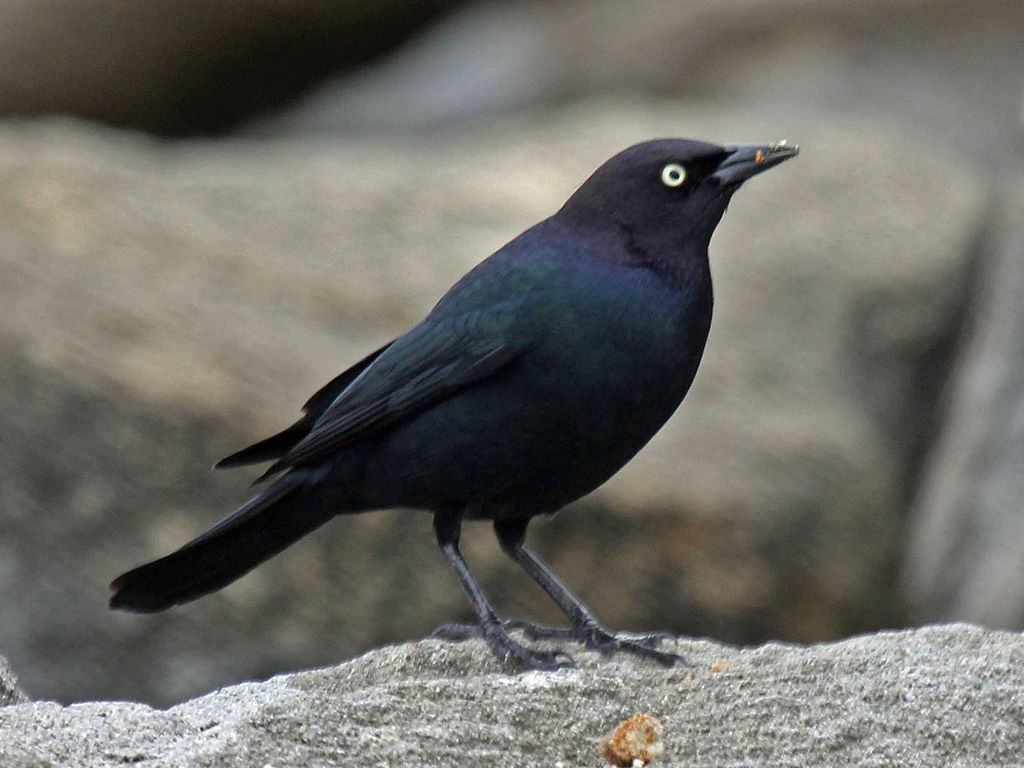Have you ever marveled at the sleek, mysterious beauty of birds that are black? From the glossy sheen of the Brewer’s Blackbird to the iridescent feathers of the Common Grackle, these birds are truly captivating. But their black coloring isn’t just for show – it serves a variety of purposes, including mate attraction and camouflage. 😍
In this article, we’ll take a closer look at some of the most fascinating birds that are black, exploring their unique features, behaviors, and habitats. Get ready to be enchanted by the world of black birds!
Table of contents
Open Table of contents
Brewer’s Blackbird: A Stunning Sight 🌟

The Brewer’s Blackbird is a medium-sized bird that’s mostly black with a white head and neck. During the breeding season, males sport a dazzling purple sheen on their heads and a blue-green gloss on their body feathers. Females, on the other hand, are a dusky brown with a light gray sheen.
These birds are part of the Icteridae family, which includes other blackbirds, meadowlarks, orioles, and grackles. They’re known for their vocal abilities and interesting behaviors, and the Brewer’s Blackbird is no exception. 🎶
Breeding and Nesting Habits 🪺
Like other blackbirds, the Brewer’s lays a clutch of 3-7 eggs each year. These eggs are green-grayish white with spots or blotches of yellow, brown, violet, and pink – a result of partial leucism, a genetic malfunction that causes certain cells in the skin to be less pigmented or not produce melanin.
The female lays her eggs in a cup-shaped nest, which she then hides in vegetation to protect the young. Both the male and female participate in the protection of the nest and feeding of the chicks, frequently chasing off predators from their territory. 💪
Habitat and Range 🌎
Brewer’s Blackbirds are generalists that can be found in most habitats, often in mixed-species flocks with other blackbirds and starlings. They’re migratory, and many spend the winter in Mexico. They’re also well-adapted to human-altered landscapes, where you might see them foraging on suburban sidewalks or scavenging crumbs at beachfront restaurants. 🍟
Vocalizations 🔊
The Brewer’s Blackbird’s “peep” call begins at birth and evolves into the familiar shrill tutz-utz-utz, which they use to warn off potential predators. During the breeding season, these birds are territorial and aggressive, defending their breeding grounds from other blackbirds and even larger animals.
Common Grackle: A Noisy Neighbor 📣

Grackles are a familiar sight to many gardeners who have bird feeders, since they often visit them in large numbers. They’re omnivorous and are known to eat corn, seeds, grains, berries, fish, small birds, and rodents. In flight, a grackle’s long tail can be spread in a “v” shape or folded down the center.
Breeding Displays 💑
Male grackles put on dramatic displays during breeding season, tipping their heads back and fluffing up feathers to display themselves and intimidate rivals. The harsh, grating call they use, which gets faster and faster as the breeding season progresses, sounds like a power line buzzing. Grackles are also noisy, and they can often be heard chirping, chattering, screeching, or squawking as they scavenge on garbage dumps and in residential yards. 🗑️
Nesting Habits 🏡
Common grackles nest in open and semiopen areas across North America east of the Rocky Mountains. They typically build well-concealed cups of plant materials in dense trees (especially pine), shrubs, or man-made structures including birdhouses. They lay four to seven eggs that the female incubates alone.
Adaptability and Nuisance Status 😠
Grackles are widely considered a nuisance by farmers, causing significant damage to fields of crops such as corn and sunflowers. Their large numbers have led to forced lethal control measures by some farmers, which may contribute to the bird’s population decline. However, they’re also well-adapted to human habitats and can be seen all year round in many urban areas.
Common Blackbird: A Melodious Songster 🎵

The Common Blackbird, Turdus merula, is a medium-sized thrush with a glossy black body and head, yellow eye-ring and bill, and black wings. It is found in North Africa, Europe, India, and southern China. Its beautiful, fluty whistled song is very well known and has been immortalized by the Beatles in their 1968 hit “Blackbird.” 🎸
Habitat and Behavior 🌳
Blackbirds are very common in woodlands but also make their homes in gardens and city parks. They are one of the most widespread species in the world and are able to adapt to different climates and habitats. They are very territorial during the breeding season, and males fiercely defend their territory, even fighting other males to keep a female or nest site.
Nesting and Diet 🍽️
The female will build a cup-shaped nest, usually in a tree or shrub. It is a sturdy structure that can withstand the winds of a storm, but it can be destroyed by squirrels or other predators. Depending on the habitat, blackbirds can lay up to three sets of eggs each year. They will eat invertebrates, such as worms and snails, as well as seeds and fruits. They are very active and are frequently seen patrolling grassy areas looking for worms, insects, and other invertebrates.
Leucism and Abnormal Plumage 🤍
While they are typically black, some individuals have white feathers contrasting with their body plumage. This is called leucism, and it has been recorded in many bird species. The BTO Abnormal Plumage Survey has logged more than 700 instances of leucistic birds, and nearly half of these are of the Common Blackbird.
Conclusion 🌟
Birds that are black are truly fascinating creatures, with their stunning plumage, unique behaviors, and adaptability to various habitats. From the Brewer’s Blackbird to the Common Grackle and the melodious Common Blackbird, these birds are a joy to watch and learn about. So the next time you spot a black bird in your backyard or local park, take a moment to appreciate its beauty and marvel at the amazing world of birds that are black. 🐦💕